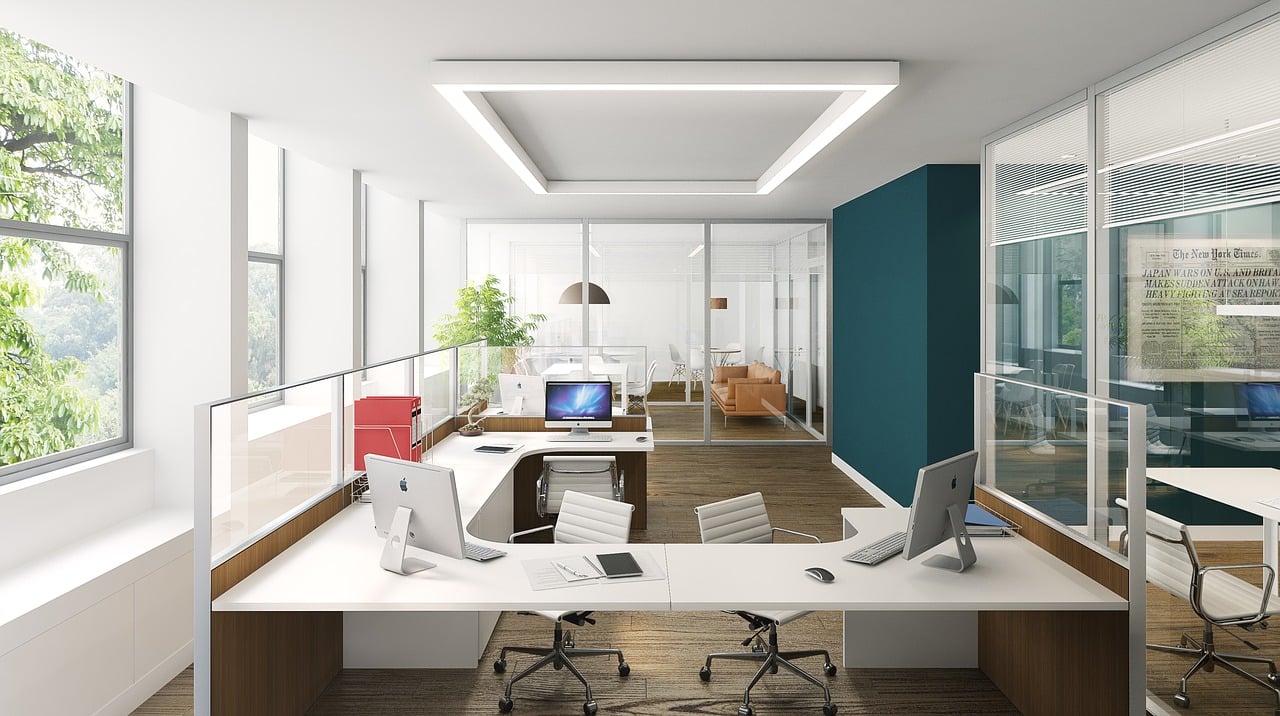When you own a commercial building, you’re looking for ways to improve its appearance, condition, and value over the long term. You also want to provide your customers, employees, and tenants with a safe and comfortable space to live, work, or conduct transactions.
If your building’s walls look dull, faded, or neglected, they may leave a poor impression on your potential customers, employees, and tenants. Dull or outdated walls can make a space feel lifeless and uninviting, diminishing the overall ambiance.
A fresh coat of paint can completely transform and brighten any room, whether at home or in a commercial setting. Investing in new paint enhances the aesthetics by adding color, vibrancy, and style. It also boosts morale, creating a more inspiring and welcoming environment for occupants. It’s a simple yet effective way to refresh a space and improve the atmosphere.
Assessing the current condition of your walls
1. Importance of evaluating the condition of the walls: Thoroughly assessing the current condition of your walls before starting any painting project is essential for achieving a smooth, long-lasting, and professional finish.
Skipping this step can result in poor paint adhesion, uneven texture, or the recurrence of underlying issues like cracks or stains. Identifying and addressing potential problems early ensures that the paint will not only look good. It will also last longer, minimizing the need for frequent touch-ups or repainting.
2. Identifying issues: As you inspect your walls, look for common issues that can affect the quality of your paint job:
- Peeling paint: Peeling or flaking paint indicates poor adhesion, moisture damage, or age. Scrape off any loose paint and sand the area smooth before repainting.
- Cracks: Small hairline cracks can be filled with spackle, but larger cracks may require patching or professional repair. Cracks are often caused by structural shifts, poor drywall installation, or temperature fluctuations, so fix them promptly to prevent recurrence.
- Stains: Water, grease, or smoke stains can bleed through new paint if not correctly treated. Clean the walls thoroughly and use a stain-blocking primer to prevent them from reappearing after painting.
- Mold or mildew: Mold and mildew can be problematic in damp areas like bathrooms or basements. Address the underlying moisture issue, clean the surface with a bleach solution, and apply a mold-resistant primer before painting.
- Nail holes and dents: These imperfections can make your new paint job look uneven. Fill them with spackle, sand the surface smoothly, and apply primer to ensure even coverage.
3. Preparing the surface for a bright and lasting finish: Once you’ve identified any issues, it’s crucial to properly prepare the surface before applying new paint. This step ensures the paint adheres well and creates a flawless finish:
- Clean the walls: Dust, dirt, and grease can prevent paint from sticking. Wash the walls with a mild soap solution, especially in kitchens or high-traffic areas. Rinse thoroughly and let them dry completely before proceeding.
- Repair damage: After cleaning, fill cracks, holes, and dents with appropriate materials like spackle or joint compound. Sand the repaired areas to make them smooth and level with the surrounding surface.
- Sand and smooth: Lightly sand the entire wall to create a slightly rough surface for better paint adhesion. Focus on previously glossy areas, as paint adheres poorly to slick surfaces.
- Prime the surface: Applying a coat of primer is essential for sealing the wall, especially if there are stains, repairs, or color changes. Primer ensures an even topcoat and enhances paint durability.
Taking the time to evaluate and prepare your walls can significantly improve the final look and longevity of your paint project, resulting in a bright and long-lasting finish.
Choosing the right paint color to brighten a space
When choosing paint to brighten a space:
- Light colors like white, light gray, and soft pastels reflect more light, making the room feel larger and brighter.
- Warm tones such as soft yellows, creams, or beiges create a cozy, inviting atmosphere.
- Cool tones like light blues or greens bring a refreshing, open feel to the space.
- Accent colors add contrast and interest by using brighter hues on one wall without overwhelming the overall lightness of the room.
Maximizing natural and artificial light with paint
Maximizing natural and artificial light with paint involves selecting colors and finishes that enhance brightness and openness.
Light colors, such as whites, pale yellows, and soft pastels, reflect natural light, making rooms feel more expansive, open, and airy.
Reflective finishes like satin or eggshell amplify this effect by bouncing light around the space. Combining these paint choices with mirrors and strategically placed light fixtures boosts natural and artificial light, creating a brighter, more inviting atmosphere.
Using glossy or semi-gloss finishes for reflective brightness
Glossy and semi-gloss finishes reflect light, enhancing the brightness of a room and making spaces feel cleaner and more open. These finishes are ideal for kitchens, bathrooms, and high-traffic areas due to their durability and easy-to-clean surfaces.
To avoid overwhelming the eyes, balance glossy finishes with matte ones. For example, apply gloss on cabinetry or trim and use matte on walls or ceilings to create visual depth and contrast without an overly shiny or harsh effect.
Creative techniques to brighten walls
- Ombre effects: This technique involves blending darker shades into lighter ones, creating a soft transition that gives the illusion of more light and space. The gradual color shift can make a room feel airy and expansive while adding a unique aesthetic.
- Textured paint: Utilizing textured paint can add depth and dimension to walls without overwhelming brightness. Textures like sponges, brushes, or rollers can create visual interest while maintaining a light color palette, enhancing the overall brightness of the room.
- Geometric patterns: Strategically applying bright colors in geometric shapes or patterns can energize a space. This modern approach can uplift the room’s atmosphere, drawing attention to specific areas and making the space feel livelier and more dynamic.
The importance of proper preparation
Proper wall preparation is crucial for achieving a smooth, bright finish when painting.
- Sanding helps create an even surface by smoothing out imperfections.
- Cleaning removes dirt and grease, allowing for better paint adhesion.
- Priming is crucial when painting over dark colors or stained walls. It helps block stains and provides a neutral base for the new color, ensuring it looks vibrant and true to its sample.
Well-prepared surfaces enhance the paint job’s longevity, allowing bright colors to pop and reducing the risk of peeling or fading over time.
Tricks to brighten small or dark spaces
Here are some tricks to brighten small or dark spaces:
- Bright, light colors: Use pale shades like whites, soft pastels, or light neutrals to reflect light and create an illusion of space. Painting walls and ceilings the same color can also help to unify the area and make it feel larger.
- Accent mirrors and glossy finishes: Incorporate mirrors to bounce light around the room. Glossy paint finishes on walls or furniture can enhance brightness by reflecting light, making the space feel more open.
- Light-colored trim: Use white or light-colored trim to contrast with walls and draw attention to architectural details, which can brighten up the overall look.
- Awkward spaces: For hallways or windowless rooms, use lighter colors and add adequate lighting fixtures like sconces or LED strips. Painting each step of a staircase a lighter color can add visual interest and brightness.
Choosing the right paint type for long-lasting brightness
- Importance of quality: Selecting high-quality, durable paints is essential for maintaining brightness over time. Premium paints often resist fading and yellowing, ensuring vibrant colors last longer.
- Considerations for high-traffic areas: Choose washable and stain-resistant paints for high-traffic areas. These features help the surfaces stay fresh and vibrant, even with regular use and exposure to dirt and wear.
- Low-VOC options: Choosing low-VOC or eco-friendly paints contributes to healthier indoor environments while still providing bright, lively colors. These options reduce harmful emissions, making them better for occupants and the planet.
Hiring a professional for the best results
Hiring a professional painter can significantly enhance your painting project for several reasons:
- Durability and aesthetic quality: Professionals ensure that the paint job looks vibrant and lasts longer by using high-quality materials and applying them correctly. Their expertise helps avoid common pitfalls that can lead to premature fading or peeling.
- Expert color selection and techniques: Professional painters bring valuable insights into color selection, guiding you to choose shades that complement your space. They apply the right techniques, ensuring even coverage and a flawless finish.
- Thorough preparation and finishing: A professional’s prep work, including surface cleaning, priming, and repairs, is crucial for achieving a smooth and bright finish. Their attention to detail in the finishing process enhances the overall appeal and longevity of the paint job.
Conclusion
Choosing the right colors, finishes, and techniques can transform dull walls and brighten any space. A thoughtful approach to your painting project more than enhances aesthetics. It also contributes to the overall mood and energy of your environment.
For expert advice and a bright, lasting transformation, contact Custom Painting, Inc. today for your painting needs! Call us at 925-294-8062 or message us on our contact page. Whether you need minor touch-ups or a full-scale repaint, we have the tools, expertise, and techniques to get the job right—on time and within budget.



